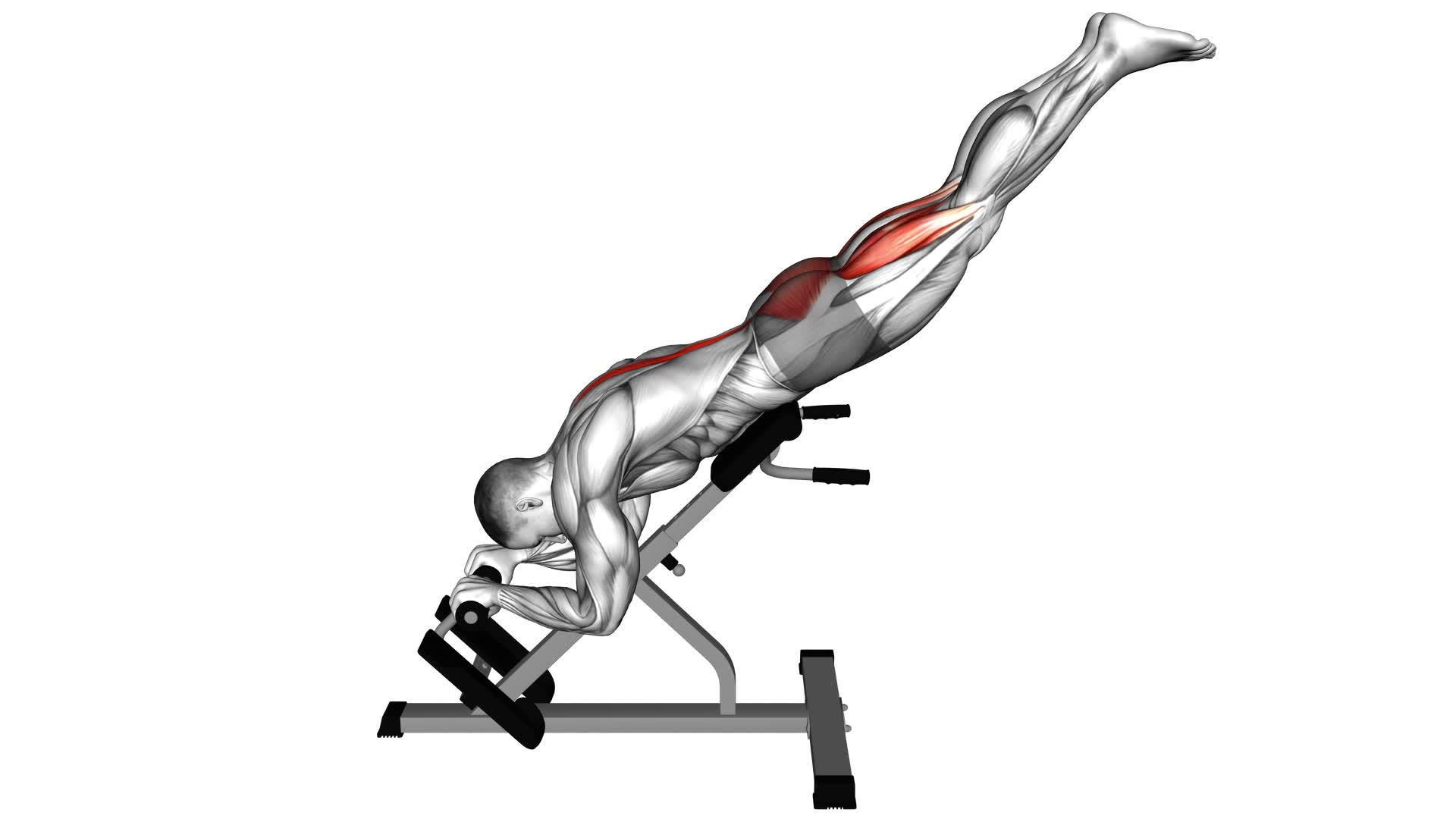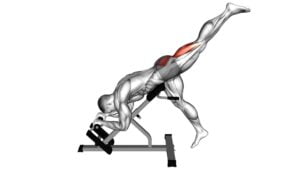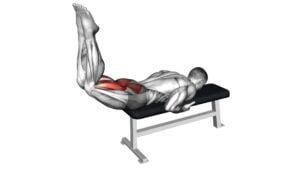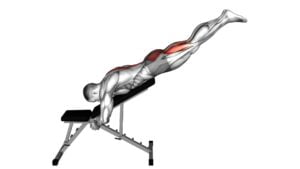45 Degrees Reverse Hyperextension – Video Exercise Guide & Tips

Are you looking for an effective exercise to target your lower back and glutes? Look no further than the 45 degrees reverse hyperextension.
Watch This Exercise Video
This video exercise guide and tips will show you the proper form and technique to maximize your results.
Whether you're a beginner or advanced fitness enthusiast, you'll find variations and modifications to suit your needs.
Get ready to strengthen and tone those posterior muscles with this challenging exercise.
Key Takeaways
- Targets lower back, glutes, and hamstrings
- Improves overall athletic performance
- Reduces the risk of injury
- Activates core muscles
Benefits of the 45 Degrees Reverse Hyperextension
You should regularly incorporate the 45 degrees reverse hyperextension into your workout routine to maximize its benefits. This exercise has numerous weightlifting benefits and is particularly effective in strengthening your core muscles.
The reverse hyperextension targets the lower back, glutes, and hamstrings, making it an ideal exercise for those looking to build strength and stability in these areas. By engaging these muscles, you can improve your overall athletic performance and reduce the risk of injury.
Additionally, the reverse hyperextension also activates the core muscles, including the abdominals and obliques. Strengthening your core is crucial for maintaining proper posture, improving balance, and enhancing overall body control.
Moreover, this exercise can help alleviate lower back pain and improve spinal alignment. The reverse hyperextension allows for decompression of the spine, relieving pressure on the discs and promoting a healthier back.
To perform the 45 degrees reverse hyperextension, lie face down on a hyperextension bench with your hips positioned at a 45-degree angle. Engage your core and lift your legs towards the ceiling while keeping them straight. Slowly lower them back down and repeat for the desired number of repetitions.
Incorporating the 45 degrees reverse hyperextension into your workout routine won't only enhance your weightlifting benefits but also strengthen your core muscles. Remember to always use proper form and consult with a fitness professional if you have any concerns or limitations.
Proper Form and Technique for the Exercise
To perform the 45 degrees reverse hyperextension with proper form and technique, it's important to focus on hip alignment and stability. Keep your hips aligned with your spine throughout the exercise to avoid any strain or injury.
Additionally, be mindful of common mistakes such as arching your back or using momentum to swing your legs, as this can compromise the effectiveness of the exercise.
Hip Alignment and Stability
Achieve optimal hip alignment and stability by maintaining proper form and technique during the Degrees Reverse Hyperextension exercise.
This exercise not only helps to strengthen your lower back, glutes, and hamstrings but also promotes hip mobility and injury prevention.
To ensure proper hip alignment, start by lying face down on the hyperextension bench with your hips positioned at the edge. Place your feet against the padded footrest and keep your legs straight.
As you raise your legs towards the ceiling, engage your glutes and lower back muscles. Avoid arching your lower back excessively and focus on using your hip muscles to lift your legs.
Remember to maintain control throughout the movement and avoid any jerky or rapid motions.
Common Mistakes to Avoid
Maintaining proper form and technique is crucial for avoiding common mistakes in the Degrees Reverse Hyperextension exercise, ensuring optimal hip alignment and stability. To perform the exercise correctly, here are some common mistakes to avoid and tips for proper technique:
- Arching the back: Keep your spine in a neutral position throughout the movement to avoid excessive strain on the lower back.
- Using momentum: Focus on controlled movements and avoid swinging your legs or using sudden jerks to lift them.
- Rounding the shoulders: Keep your shoulders relaxed and down, maintaining a tall posture throughout the exercise.
- Neglecting core engagement: Engage your core muscles by pulling your belly button towards your spine, providing stability and support for your lower back.
By following these tips and avoiding these common mistakes, you can ensure that you're performing the Degrees Reverse Hyperextension exercise with proper form and technique.
Now let's move on to the next section, which discusses the equipment needed for performing the exercise.
Equipment Needed for Performing the Exercise
You will need a bench or a hyperextension machine to perform the Degrees Reverse Hyperextension exercise. This exercise primarily targets your lower back muscles, but it also engages your glutes and hamstrings.
To perform this exercise, start by securing your feet under the footpads of the machine or placing them firmly on the bench. Position your body so that your hips are slightly off the edge of the bench or machine. Cross your arms over your chest or place your hands behind your head.
Lower your upper body towards the ground while keeping your back straight. Pause briefly when your body is parallel to the ground, and then raise your upper body back to the starting position.
As you become more comfortable with the exercise, you can increase the difficulty by holding weights or using resistance bands. Remember to always maintain proper form and avoid using momentum to complete the movement.
Transitioning into the next section about common mistakes to avoid, it's important to be mindful of your technique to prevent injury and maximize the effectiveness of the exercise.
Common Mistakes to Avoid During the Exercise
To maximize the effectiveness of the Degrees Reverse Hyperextension exercise, steer clear of falling into common mistakes. Avoiding injuries and maximizing results should be your top priorities. Here are some common mistakes to avoid during the exercise:
- Using momentum: It's important to perform the exercise in a controlled manner, focusing on the contraction of your glutes and hamstrings. Avoid swinging your legs or using momentum to lift your body.
- Arching your back: Keep your back flat and aligned with your spine throughout the exercise. Arching your back can put unnecessary strain on your lower back and increase the risk of injury.
- Neglecting proper form: Ensure that your hips are fully extended at the top of the movement and that you're not overextending or hyperextending your lower back. Maintain a neutral spine position to engage the correct muscles.
- Not engaging your core: Your core muscles play a crucial role in stabilizing your body during the exercise. Remember to engage your core by drawing your belly button towards your spine and maintaining a strong core throughout the movement.
By avoiding these common mistakes, you can reduce the risk of injury and maximize the results of the Degrees Reverse Hyperextension exercise.
Now, let's move on to discussing variations and modifications for all fitness levels.
Variations and Modifications for All Fitness Levels
Now let's explore some variations and modifications that cater to all fitness levels.
If you're a beginner, there are beginner-friendly modifications available to help you ease into the exercise.
On the other hand, if you're at an advanced level, there are variations that can challenge you further.
Additionally, don't forget that you can always customize the exercise to fit your individual needs and goals.
Beginner-Friendly Modifications
Make modifications to the degrees reverse hyperextension exercise to suit your fitness level. Here are some beginner-friendly modifications and progressions for advanced levels:
- Decrease the range of motion: If you're a beginner, you can start by performing the exercise with a smaller range of motion. Gradually increase it as you get stronger and more comfortable.
- Use a stability ball: Placing a stability ball under your hips can provide additional support and make the exercise easier for beginners. As you progress, you can remove the ball and perform the exercise on a flat surface.
- Perform the exercise on an incline: Beginners can start by performing the degrees reverse hyperextension on an incline bench. This reduces the resistance and makes it easier to execute the movement correctly. As you advance, you can gradually decrease the incline until you can perform the exercise on a flat surface.
- Add resistance: For advanced levels, you can make the exercise more challenging by adding resistance bands or holding a weight plate against your chest.
Remember to always listen to your body and make modifications that suit your fitness level.
Advanced Level Variations
As you progress to advanced levels, you can further customize the degrees reverse hyperextension exercise to challenge your fitness abilities. Here are some advanced modifications and techniques to consider.
- First, you can increase the range of motion by extending your legs higher during the exercise. This will engage your glutes and hamstrings even more.
- Another advanced modification is to add resistance by holding a dumbbell or weight plate against your chest. This will intensify the exercise and target your lower back muscles.
- Additionally, you can perform the exercise on an unstable surface, such as a stability ball or a balance board, to engage your core and improve your balance.
Remember to always maintain proper form and technique to prevent injury.
Incorporating these advanced level variations will help you push your limits and continue challenging your fitness level.
Customizing for Individual Needs
To customize the degrees reverse hyperextension exercise for your individual needs, consider incorporating variations and modifications for all fitness levels. Here are some ideas for individual modifications and personalized adaptations:
- Adjust the range of motion: Start with smaller movements and gradually increase the range as your flexibility and strength improve.
- Use props or equipment: Incorporate resistance bands or weights to add intensity or support if needed.
- Modify the starting position: If lying face down is uncomfortable, try performing the exercise on an incline bench or stability ball.
- Focus on specific muscle groups: Emphasize the hamstrings, glutes, or lower back by adjusting your body position or using different variations of the exercise.
By tailoring the degrees reverse hyperextension exercise to your specific needs, you can maximize its benefits and avoid any potential discomfort or injury.
Now, let's move on to some tips for incorporating this exercise into your workout routine.
Tips for Incorporating the Exercise Into Your Workout Routine
Start by incorporating the exercise into your workout routine by including it as a core strengthening exercise. Degrees Reverse Hyperextension can be a valuable addition to your fitness regimen, providing several benefits for your body.
To make the exercise more challenging, consider incorporating weights. You can hold a dumbbell or a weight plate against your chest while performing the movement. This will add resistance and help build strength in your lower back, glutes, and hamstrings. However, it's important to start with a weight that's manageable and gradually increase it over time to avoid injury.
If you're unable to perform the Degrees Reverse Hyperextension due to any limitations or discomfort, there are alternative exercises you can try. One option is the Superman exercise, which involves lying face down on the floor and simultaneously lifting your arms and legs off the ground. This exercise targets similar muscle groups and can help improve core stability.
Another alternative is the Bird Dog exercise, where you start on all fours and extend one arm and the opposite leg, maintaining a straight line from head to toe. This exercise also engages the core muscles and promotes stability.
Incorporating the Degrees Reverse Hyperextension into your workout routine can enhance your core strength and stability. By adding weights or trying alternative exercises, you can customize the workout to suit your needs and preferences. Remember to always listen to your body and consult a professional if you have any concerns or questions.
Frequently Asked Questions
Can the 45 Degrees Reverse Hyperextension Exercise Help With Lower Back Pain?
The 45 degrees reverse hyperextension exercise can be beneficial for lower back pain.
By engaging your core muscles, this exercise helps to strengthen and stabilize your back, reducing the risk of injury and alleviating pain.
To perform this exercise properly, lie face down on a hyperextension bench, place your ankles under the foot pads, and lower your upper body to a 45-degree angle.
Lift your torso back up, using your lower back muscles, and repeat for the desired number of reps.
How Many Sets and Reps Should I Do for the 45 Degrees Reverse Hyperextension Exercise?
To determine the number of sets and reps for the 45 degrees reverse hyperextension exercise, consider your fitness level and goals. Start with 2-3 sets of 10-12 reps, gradually increasing as you progress.
This exercise benefits your lower back by strengthening the muscles and improving stability. Remember to maintain proper form and consult with a professional if you have any concerns or medical conditions.
Stay consistent and listen to your body for optimal results.
Is It Safe to Perform the 45 Degrees Reverse Hyperextension Exercise Without a Spotter?
Yes, it's generally safe to perform the 45 degrees reverse hyperextension exercise without a spotter. However, it's always recommended to use proper form and start with lighter weights to avoid injury.
If you're unsure or uncomfortable performing this exercise without a spotter, there are alternative exercises that target similar muscle groups, such as glute bridges or supermans.
Remember to listen to your body and stop if you experience any pain or discomfort.
Can the 45 Degrees Reverse Hyperextension Exercise Be Done at Home Without Any Equipment?
Yes, you can perform the 45 degrees reverse hyperextension exercise at home without any equipment.
This exercise has several benefits, including strengthening your lower back, glutes, and hamstrings.
To modify this exercise at home, you can use a stability ball or a bench to support your hips and perform the movement.
Remember to maintain proper form and start with a lower range of motion if you're a beginner.
Always listen to your body and stop if you feel any pain or discomfort.
Are There Any Precautions or Contraindications for Individuals With Pre-Existing Back Injuries or Conditions When Performing the 45 Degrees Reverse Hyperextension Exercise?
When performing the 45 degrees reverse hyperextension exercise, it's important to be aware of any precautions or contraindications, especially if you have pre-existing back injuries or conditions.
It's recommended to consult with a healthcare professional or a qualified fitness trainer before attempting this exercise. They can provide guidance and ensure that it's safe for you to perform, or suggest alternative exercises that may be more suitable for your specific situation.
Safety should always be a priority when it comes to exercising with any pre-existing injuries or conditions.
Conclusion
Incorporating the 45 degrees reverse hyperextension into your workout routine can provide numerous benefits, such as strengthening your lower back and glutes.
By following proper form and technique, using the necessary equipment, and avoiding common mistakes, you can maximize the effectiveness of this exercise.
Additionally, there are variations and modifications available for all fitness levels, making it accessible to everyone.
Add this exercise to your routine and enjoy the benefits it brings to your overall fitness.

Author
Years ago, the spark of my life’s passion ignited in my mind the moment I stepped into the local gym for the first time. The inaugural bead of perspiration, the initial endeavor, the very first surge of endorphins, and a sense of pride that washed over me post-workout marked the beginning of my deep-seated interest in strength sports, fitness, and sports nutrition. This very curiosity blossomed rapidly into a profound fascination, propelling me to earn a Master’s degree in Physical Education from the Academy of Physical Education in Krakow, followed by a Sports Manager diploma from the Jagiellonian University. My journey of growth led me to gain more specialized qualifications, such as being a certified personal trainer with a focus on sports dietetics, a lifeguard, and an instructor for wellness and corrective gymnastics. Theoretical knowledge paired seamlessly with practical experience, reinforcing my belief that the transformation of individuals under my guidance was also a reflection of my personal growth. This belief holds true even today. Each day, I strive to push the boundaries and explore new realms. These realms gently elevate me to greater heights. The unique combination of passion for my field and the continuous quest for growth fuels my drive to break new ground.



